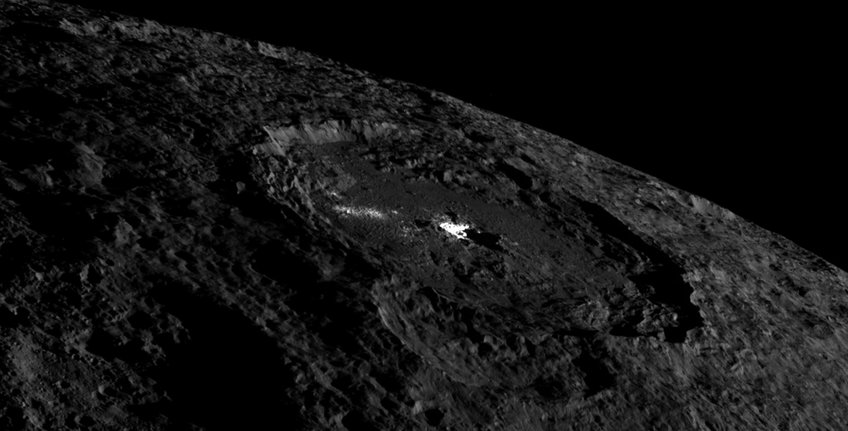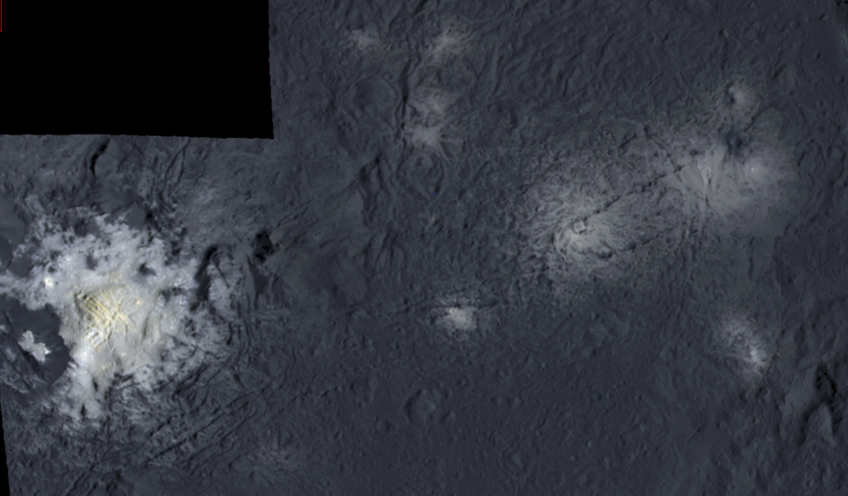Cryovolcanism on Dwarf Planet Ceres
Highly resolved images of Occator crater show evidence for long-lasting geologic activity.
Among the most striking features on the surface of Ceres are the bright spots in the center of Occator crater which stood out already as NASA’s space probe Dawn approached the dwarf planet. Scientists under the leadership of the Max Planck Institute for Solar System Research (MPS) have now for the first time determined the age of this bright material, which consists mainly of deposits of special mineral salts. With about four million years only, these deposits are about 30 million years younger than the crater itself. This, as well as the distribution and nature of the bright material within the crater, suggests that Occator crater has been the scene of eruptive outbursts of subsurface brine over a long period and until almost recently. Ceres is thus the body closest to the Sun that shows cryovolcanic activity.

For nearly two years, the NASA’s space probe Dawn has been accompanying dwarf planet Ceres, which orbits the Sun within the asteroid belt between Mars and Jupiter. During the first part of the mission, the probe advanced to lower and lower orbits until between December 2015 and September 2016 only approximately 375 kilometers separated it from the surface. During this so-called Low Altitude Mapping Orbit the Dawn Framing Cameras produced highly resolved images of Ceres’ surface displaying a resolution of 35 meters per pixel. The Dawn Framing Cameras, Dawn’s scientific imaging system, were developed and built and are operated under the leadership of the MPS.
MPS researchers have now thoroughly investigated the complex geological structures that are shown in the detailed images of Occator crater. These structures include fractures, avalanches, and younger, smaller craters. "In these data, the origin and evolution of the crater as it presents itself today can be read more clearly than ever before”, says Andreas Nathues, Framing Camera Lead Investigator. Additional indications were provided by measurements of the infrared spectrometer VIR onboard Dawn.

Occator crater located in the northern hemisphere of Ceres measures 92 kilometers in diameter. In its center a pit with a diameter of about 11 kilometers can be found. On some parts of its edges, jagged mountains and steep slopes rise up to 750 meters high. Within the pit a bright dome formed. It has a diameter of 3 kilometers, is 400 meters high and displays prominent fractures.
"This dome contains the brightest material on Ceres," says MPS scientist Thomas Platz. Researchers call the bright material in the central pit Cerealia Facula. VIR data show that it is rich in certain salts, so-called carbonates. Since later impacts in this area did not expose any other material from the depth, this dome possibly consists entirely of bright material. The scattered bright spots (Vinalia Faculae) located further outside in the crater are paler, form a thinner layer and – as VIR and camera data show - turn out to be a mixture of carbonates and dark surrounding material.

Nathues and his team interpret the central pit with its rocky, jagged ridge as a remnant of a former central mountain. It formed as a result of the impact that created Occator Crater some 34 million years ago and collapsed later. The dome of bright material is much younger: only approximately four million years. The key to determining these ages was the accurate counting and measuring of smaller craters torn by later impacts. This method’s basic assumption is that surfaces showing many craters are older than those that are less strongly "perforated". Since even very small craters are visible in highly resolved images, the new study contains the most accurate dating so far.
"The age and appearance of the material surrounding the bright dome indicate that Cerealia Facula was formed by a recurring, eruptive process, which also hurled material into more outward regions of the central pit”, says Nathues. "A single eruptive event is rather unlikely," he adds. A look into the Jupiter system supports this theory. The moons Callisto and Ganymede show similar domes. Researchers interpret them as volcanic deposits and thus as signs of cryovolcanism.
The MPS scientists assume that a similar process is active on Ceres. "The large impact that tore the giant Occator crater into the surface of the dwarf planet must have originally started everything and triggered the later cryovolcanic activity," says Nathues. Following the disruption of the impact, the brine researchers suspect either as a complete layer or as scattered patches under the rocky mantel was able to move closer to the surface. The lower pressure allowed water and dissolved gases, such as methane and carbon dioxide, to escape forming a system of vents. At the surface, fractures appeared through which the saturated solution erupted from the depth. The deposited salts gradually formed the present dome.
The last of these eruptions must have created the present surface of the dome four million years ago. Whether the cryovolcanic activity has ceased completely or is ongoing on a lower level, is still unclear. Pictures of the crater showing haze when imaged at certain angles seem to speak for the latter. At the end of 2015 already, MPS researchers explained this phenomenon with the sublimation of water.
Recent investigations support this interpretation. The MPS researchers evaluated numerous images of Occator crater from an early phase of the mission taken from a distance of 14,000 kilometers and from low angles. They clearly show variations in brightness following a diurnal rhythm. “The nature of the light scattering at the bottom of Occator differs fundamentally from that at other parts of the Ceres surface," MPS researcher Guneshwar Singh Thangjam describes the result of his analysis. "The most likely explanation is that near the crater floor an optically thin, semi-transparent haze is formed," he adds. The researchers believe that the haze is possibly formed by sublimating water emerging from fractures in the floor of the crater when exposed to sunlight.
Dawn's mission to Vesta and Ceres is managed by the Jet Propulsion Laboratory for NASA's Science Mission Directorate in Washington. Dawn is a project of the directorate's Discovery Program, managed by NASA's Marshall Space Flight Center in Huntsville, Alabama. UCLA is responsible for overall Dawn mission science. Orbital ATK, Inc., of Dulles, Virginia, designed and built the spacecraft. JPL is managed for NASA by the California Institute of Technology in Pasadena. The framing cameras were provided by the Max Planck Institute for Solar System Research, Gottingen, Germany, with significant contributions by the German Aerospace Center (DLR) Institute of Planetary Research, Berlin, and in coordination with the Institute of Computer and Communication Network Engineering, Braunschweig. The framing camera project is funded by the Max Planck Society, DLR, and NASA. The spectrometer VIR was provided by the Italien Space Agency ASI and is operated by the National Institute for Astrophysics in Rome in collaboration with Selex Galileo.


